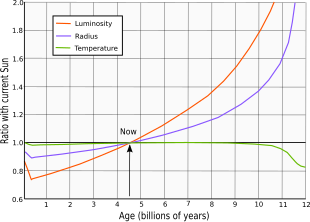| 1 R☉ = | Units |
|---|---|
| 6.95700×108 | metres |
| 695,700 | kilometres |
| 0.00465047 | astronomical unit |
| 432,288 | miles |
| 7.35355×10−8 | light-year |
| 2.25461×10−8 | parsec |
| 2.32061 | light-seconds |
Solar radius is a unit of distance used to express the size of stars in astronomy relative to the Sun. The solar radius is usually defined as the radius to the layer in the Sun's photosphere where the optical depth equals 2/3:[1]
695,700 kilometres (432,300 miles) is approximately 10 times the average radius of Jupiter, 109 times the radius of the Earth, and 1/215th of an astronomical unit, the approximate distance between Earth and the Sun. The solar radius to either pole and that to the equator differ slightly due to the Sun's rotation, which induces an oblateness in the order of 10 parts per million.[2]
Measurements

The uncrewed SOHO spacecraft was used to measure the radius of the Sun by timing transits of Mercury across the surface during 2003 and 2006. The result was a measured radius of 696,342 ± 65 kilometres (432,687 ± 40 miles).[4]
Haberreiter, Schmutz & Kosovichev (2008)[1] determined the radius corresponding to the solar photosphere to be 695,660 ± 140 kilometres (432,263 ± 87 miles). This new value is consistent with helioseismic estimates; the same study showed that previous estimates using inflection point methods had been overestimated by approximately 300 km (190 mi).
Nominal solar radius
In 2015, the International Astronomical Union passed Resolution B3, which defined a set of nominal conversion constants for stellar and planetary astronomy. Resolution B3 defined the nominal solar radius (symbol 
Examples
Solar radii as a unit are common when describing spacecraft moving close to the sun. Two spacecraft in the 2010s include:
- Solar Orbiter (as close as 45 R☉)
- Parker Solar Probe (as close as 9 R☉)
| Name | Radius (Solar radius) | Radius (kilometers) |
|---|---|---|
| Milky Way | 5.94×1011 | 4.134×1017[7] |
| WOH G64 (largest known star) | 1,540[8] | 1,071,378,000 |
| UY Scuti | 909[9] | 632,400,000 |
| Betelgeuse | 764[10] | 531,500,000 |
| Antares A | 680[11] | 473,076,000 |
| Rigel A | 74.1[12] | 51,550,000 |
| Aldebaran | 45.1[13] | 31,375,000 |
| Arcturus | 25.4[14] | 17,670,000 |
| Pollux | 9.06[15] | 6,300,000 |
| Sirius A | 1.711[16] | 1,190,350 |
| Sun | 1 | 695,700 |
| Proxima Centauri | 0.1542[17] | 107,275 |
| Jupiter | 0.1028 | 71,492[18] |
| Saturn | 0.0866 | 60,268[18] |
| Uranus | 0.03673 | 25,559[18] |
| Neptune | 0.03559 | 24,764[18] |
| Earth | 0.009168 | 6,378[18] |
| Venus | 0.00869 | 6,051.8[18] |
| Mars | 0.00488 | 3,396.19[18] |
| Mercury | 0.0035 | 2,440.53[18] |
| Moon | 0.0025 | 1,738.1[19] |
| Pluto | 0.0017 | 1,188.3[18] |
See also
References
External links
- S. C. Tripathy; H. M. Antia (1999). "Influence of surface layers on the seismic estimate of the solar radius". Solar Physics. 186 (1/2): 1–11. Bibcode:1999SoPh..186....1T. doi:10.1023/A:1005116830445. S2CID 118037693.
- T. M. Brown; J. Christensen-Dalsgaard (1998). "Accurate Determination of the Solar Photospheric Radius". Astrophysical Journal Letters. 500 (2): L195. arXiv:astro-ph/9803131. Bibcode:1998ApJ...500L.195B. doi:10.1086/311416. S2CID 13875360.






